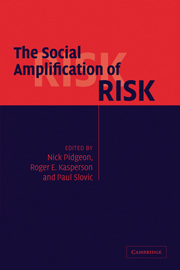Book contents
- Frontmatter
- Contents
- List of figures
- List of tables
- List of contributors
- Acknowledgments
- Introduction
- Part I Conceptual foundations
- Part II Risk signals and the mass media
- 5 Trust, transparency, and social context: implications for social amplification of risk
- 6 Risk and relativity: BSE and the British media
- 7 After amplification: rethinking the role of the media in risk communication
- 8 Plague and arsenic: assignment of blame in the mass media and the social amplification and attenuation of risk
- Part III Public perceptions and social controversy
- Part IV Risk ripples and stigma effects
- Part V Policy and management
- Bibliography
- Index
7 - After amplification: rethinking the role of the media in risk communication
Published online by Cambridge University Press: 06 July 2010
- Frontmatter
- Contents
- List of figures
- List of tables
- List of contributors
- Acknowledgments
- Introduction
- Part I Conceptual foundations
- Part II Risk signals and the mass media
- 5 Trust, transparency, and social context: implications for social amplification of risk
- 6 Risk and relativity: BSE and the British media
- 7 After amplification: rethinking the role of the media in risk communication
- 8 Plague and arsenic: assignment of blame in the mass media and the social amplification and attenuation of risk
- Part III Public perceptions and social controversy
- Part IV Risk ripples and stigma effects
- Part V Policy and management
- Bibliography
- Index
Summary
This chapter responds to the challenge from the proponents of the social amplification of risk framework (SARF) a decade ago, that future research should focus on the interaction between risks (as conventionally calibrated) and “the psychological, social, institutional, and cultural processes” which generate interpretations that may “heighten or attenuate public perceptions of risk and shape risk behavior” (Kasperson 1992, pp. 157–158). In particular the discussion tackles a core, unresolved question at the heart of SARF relating to the mass media's pivotal role as a “station” for relaying “signals” and constructing public representations of risk (Kasperson and Kasperson 1996, p. 97).
SARF was presented as a “fledgling conceptual framework” rather than “a fully developed theory” (Kasperson, Renn, Slovic et al. 1988, p. 180), and its proponents expressly invited “scrutiny, elaboration, and competing views” (p. 187). However, while primarily intended as a stimulus to debate within the professional risk research and policy making communities, there were suggestions that SARF could also provide a productive departure point for broader assessments of the state of democratic life. The dispute over the nuclear waste facility at Yucca Mountain Nevada, that had served to prompt questions about risk amplification mechanisms, confirmed an apparent increasing breakdown of trust between citizens and governments. In common with many political scientists and commentators Kasperson and his co-workers saw this evaporation of trust affecting “all social institutions and public orientations towards particular policies or decision areas” (Kasperson, Golding, and Tuler 1992, pp. 176–177) although it appeared particularly marked in relation to risk issues.
- Type
- Chapter
- Information
- The Social Amplification of Risk , pp. 156 - 178Publisher: Cambridge University PressPrint publication year: 2003
- 68
- Cited by



